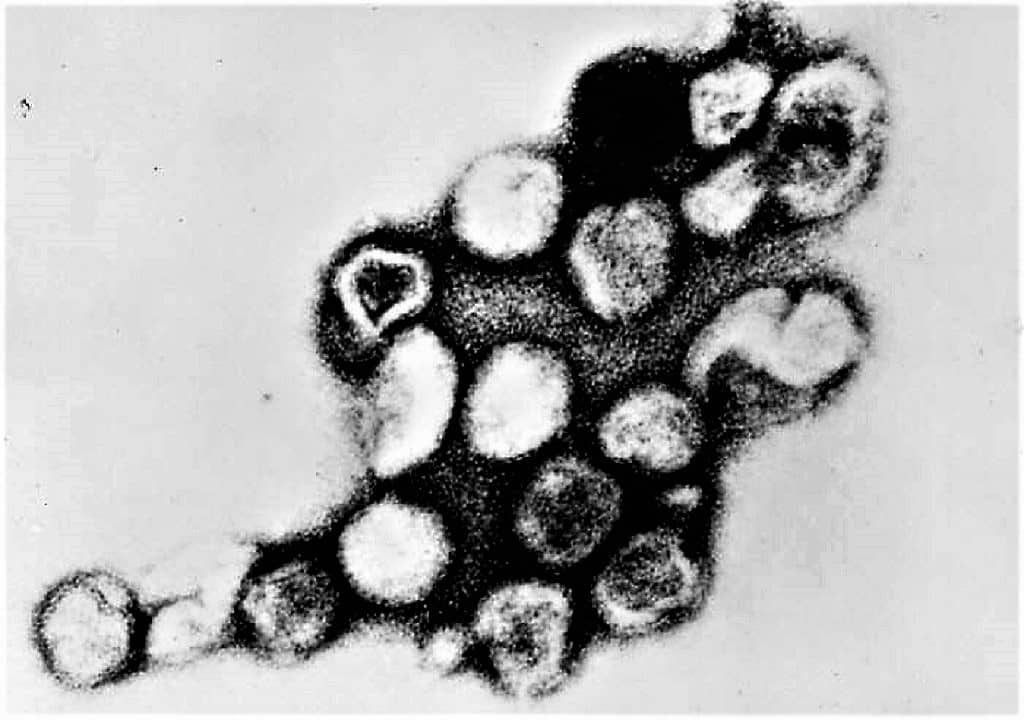INTRODUCTION TO RUBELLA VIRUS
⇒ RUBELLA VIRUS is the causative agent of disease Rubella or German measles, a mild exanthematous fever which may be acquired Congenitally or Postnatally.
⇒ It was first described by an Australian Ophthalmologist Gregg in 1941 & was first isolated in tissue cultures in 1962.
⇒ This virus belongs to the Rubivirus genus of Togaviridae Family.
MORPHOLOGY OF RUBELLA VIRUS
⇒ Rubella virus is pleomorphic, roughly spherical & enveloped particle.
⇒ Envelope carries the Hemagglutinin peplomers.

⇒ Size: 50-70 nm in diameter.
⇒ Genetic Material:- ssRNA.
RESISTANCE SHOWN BY RUBELLA VIRUS
⇒ Rubella virus is heat labile – destroyed by eating at 56°
⇒ It is inactivated by Ether, Chloroform & Formaldehyde.
⇒ It can survive at -56°C for several years.
CULTIVATION OF RUBELLA VIRUS
⇒ It can be grown in many primary cell tine cultures & continuous cell line cultures, Such as,
- Rabbit Kidney (RK 13)
- Baby Hamster Kidney (BHK 21)
- Vero cell cine culture.
- Human Amnion tissue culture.
- Human thyroid tissue culture
PATHOGENESIS OF RUBELLA VIRUS
⇒ Rubella virus is the causative agent of disease Rubella or German measles, a mild exanthematous fever characterized by transient macular rash and Lymphadenopathy.
The infection of Rubella is acquired
by inhalation.
⇓
The replication of virus occurs in
Cervical lymph nodes.
⇓
Viremia occurs and can be demonstrated
As early as the 7th day before the rash.
⇓
After about 7 days of viremia, the rashes develop,
First on the face and then spreading to the neck, trunk
and extremities sparing palms & soles.
CLINICAL FEATURES OF GERMAN MEASLES
⇒ The incubation period of Rubella virus is 9-11 days.
⇒ The common symptoms include –
- Rashes
- Fever
- Lymphadenopathy
- Arthritis
⇒ The disease occurs principally in children but may affect all ages.
⇒ Rubella can be of two types – Congenital or Post-Natal Rubella.
⇒ If rubella occurs in early pregnancy, the fetus may die. Transient effects observed in infants with Congenital Rubella infection includes –
- Cardiac defects
- Cataract
- Deafness
- Hepatosplenomegaly
- Thrombocytopenic purpura
- Myocarditis
- Bone lesions
- Mental retardation
⇒ In neonates and Adults, infection occurs through the mucosa of the upper Respiratory tract and termed as post-natal rubella infection.
⇒ The symptom of postnatal rubella begins with Malaise followed by fever, lymphadenopathy, and Rashes; arthritis is more common in females.
LABORATORY DIAGNOSIS OF RUBELLA VIRUS
⇒ In Pregnancy: Diagnosis can be done by virus isolation or serology. The virus can be isolated from blood during the early stage in RK or Vero cells. Virus-specific IgG and IgM antibodies can be detected by ELISA.
⇒ In congenital rubella: Virus can be isolated from urine, leucocytes, bone marrow or CSF. Viral-specific IgM antibodies can be detected in newborns.
PROPHYLAXIS OF GERMAN MEASLES
⇒ Live attenuated vaccine for rubella is available and can be administered subcutaneously.
⇒ A combined mumps-measles-rubella (MMR) vaccine is recommended for the infants at the age of 5 months, followed by a booster at the age of 4-6 years.

Hi, I’m the Founder and Developer of Paramedics World, a blog truly devoted to Paramedics. I am a Medical Lab Tech, a Web Developer and Bibliophiliac. My greatest hobby is to teach and motivate other peoples to do whatever they wanna do in life.
Very informative information
Plz share about nutritional rickets
Thanks… Will Publish Soon.
Thorough virus profile.
Complete disease guide.